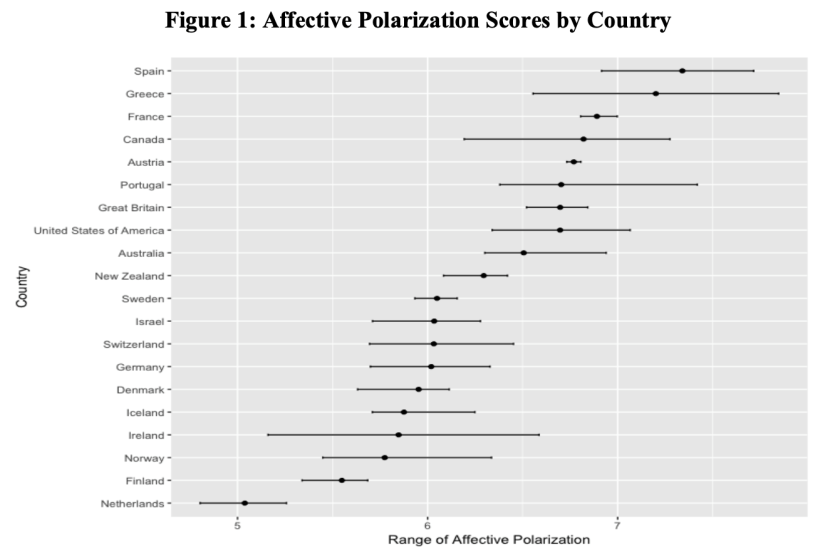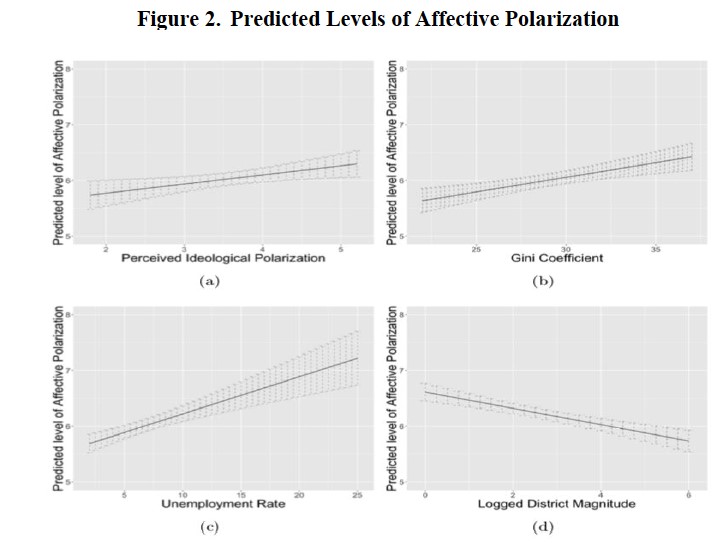Summary by Noam Gidron, James Adams, and Will Horne
Concerns over the health of democratic norms and institutions have intensified in recent years (e.g., Levitsky and Ziblatt 2018), with political polarization often cited as a key driver of democratic dysfunction. The rise of affective polarization in the mass public, defined as dislike and hostility across partisan lines (Iyengar et al. 2012), is especially disconcerting because it damages trust across partisan lines. Yet most of our knowledge about this important phenomenon is drawn from the American case. Analyzing affective polarization in a comparative perspective may improve our understanding of its causes and effects, as well as what is, and is not, unique about the American case. In our comparative study we find that the United States actually displays relatively moderate affective polarization when compared with other democratic polities. We also find evidence that institutional and economic conditions shape affective polarization.
We analyze 76 national election surveys across 20 countries between 1996 and 2015 using data from the Comparative Study of Electoral Systems. We first create a measure of country-level affective polarization that captures how much the average partisan in the country dislikes all parties other than the one they support. This allows us to compute an affective polarization score for each election in each country in our data set. We find that affective polarization in the American public is not high in comparative perspective. Only a handful of the countries in our study display notably less intense mass-level affective polarization than the US. Figure 1 displays the average and range of affective polarization scores in each country over the period of our study, where higher values on the horizontal axis denote more intense affective polarization:

To analyze variations in affective polarization, we first evaluated whether affective polarization was driven by increasing levels of elite polarization. Using different measures of elite polarization, we found no consistent evidence that out-party dislike is driven by greater ideological differences between rival parties’ elites. In contrast, unemployment is strongly associated with affective polarization: in cross-national comparisons we find that countries with higher unemployment display more intense mass-level affective polarization, and in within-country comparisons we find that affective polarization intensifies as the national unemployment rate rises. We also find cross-national evidence that economic inequality intensifies affective polarization (McCarty et al, 2006). Finally, in support of arguments originally developed by Lijphart (1999), we find that countries whose political systems foster more power-sharing between parties display markedly less affective polarization in the mass public, all else equal. Taken together, these findings suggest that affective polarization is driven more by structural economic and institutional factors than by ideological differences between rival parties’ elites. Figure 2 displays the predicted levels of mass affective polarization across a range of values for the institutional, economic, and ideological variables that we study:

Our analysis is a first step towards a comparative research agenda on mass-level affective polarization. We have shown that the American case is not an outlier, which suggests that American politics scholars may learn more about their case by placing it in a broader comparative context. In future research we will extend our analyses of the link between elite ideological polarization and mass-level affective polarization to consider more focused dimensions of policy debates, including elite disputes over nationalism and over economic policy.
 About the Authors: Noam Gidron is an assistant professor in the Department of Political Science and the Joint Program in Politics, Philosophy and Economics (PPE) at the Hebrew University of Jerusalem. James Adams is a Professor in the Department of Political Science at UC Davis, and Will Horne is a graduate student in the Department of Politics at Princeton University. They received the 2019 MPSA Kellogg/Notre Dame Award for their research “The Causes of Mass-level Affective Polarization in Advanced Democracies”.
About the Authors: Noam Gidron is an assistant professor in the Department of Political Science and the Joint Program in Politics, Philosophy and Economics (PPE) at the Hebrew University of Jerusalem. James Adams is a Professor in the Department of Political Science at UC Davis, and Will Horne is a graduate student in the Department of Politics at Princeton University. They received the 2019 MPSA Kellogg/Notre Dame Award for their research “The Causes of Mass-level Affective Polarization in Advanced Democracies”.
References
Iyengar, Shanto, Gaurav Sood and Yphtach Lelkes. (2012). ‘Affect, Not Ideology.’ Public Opinion Quarterly, 76(3):405–431.
Levitsky, Steven, and Daniel Ziblatt. (2018). How Democracies Die. New York: Crown.
Lijphart, Arend. 1999. Patterns of Democracy: Government Forms and Performance in Thirty-Six Countries. New Haven: Yale University Press.
McCarty, Nolan, Keith T. Poole and Howard Rosenthal. (2006). Polarized America: The Dance of Ideology and Unequal Riches. Cambridge: MIT Press.
